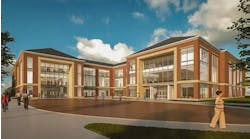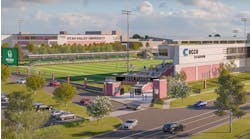Athletic programs often present a challenge for schools striving to accommodate increasing numbers of participants and activities. The demands for playing space can be great — not only in the size of the fields, but also in the number of users and the quality of the surfaces. Natural grass remains the standard for sports fields, but new developments in synthetic turf technologies have created options that are worth a closer look.
From the ground up
For many years, the only way to have a playing field was to grow it out of the ground. Still the most prevalent surface and a sentimental favorite, natural turf is nonetheless difficult and expensive to maintain properly. Constant use is hard on natural grass, and high-traffic areas, such as the goalkeeper boxes on a soccer field, often sustain extensive damage.
In wet or cold climates, rain, snow and ice can contribute to the early demise of even well-kept fields. Turf science has developed over the years, and grasses today are hardier and more durable than in the past. However, they are not immune to damage, and modern-day event scheduling means that schools are on their fields much of the time.
The 1960s saw the advent of synthetic turf. The material made it easier to stage football and baseball games at indoor venues. The most prominent example was the Astrodome in Houston, which gave the product its commonly known name, AstroTurf.
After the novelty of synthetic turf wore off, serious problems arose; the fields usually were less attractive and more costly than the natural grass fields they replaced, and they soon were seen as more dangerous. The harder artificial surface was blamed for a rise in injuries, even lending its name to new ailments such as “turf toe.”
Newer synthetic turfs are vastly improved compared with the old AstroTurf-style products; they have softer yarns and built-in cushioning layers. Synthetic turf nowadays is more of a system than a product. It begins with drainage piping installed in a porous stone base on the existing earth. The long-fibered turf carpet then is placed on top of this base and seamed together. The carpet backing is manufactured to allow rainwater to pass through it into the stone base. Finally, the turf is infilled with granulated rubber (usually recycled automobile tires) or a mixture of granulated rubber and sand. The resulting field is attractive, durable, weather-resistant and safe.
Head to head
The differences between natural and synthetic turf are striking. So, depending on the particular application, one or the other may be best. It is necessary to look at the materials side by side for a complete evaluation. Some aspects are compared easily, such as costs and maintenance. Other aspects, like safety and performance, are harder to analyze because a large body of long-term data is not yet available. Some considerations:
- Performance
Synthetic turf can be used in all kinds of weather and by many different groups without risking damage. Even the best natural fields must have time to recover between events, and playing a game in the rain can mean destroying the field for an entire season. However, synthetic fields are available for use almost anytime. The porous materials drain water at rates exceeding 14 inches per hour, so teams can continue to play in the rain or retake the field quickly after a severe storm.
Athletes say they enjoy playing on synthetic turf, and some report feeling faster and more agile on these surfaces. Special shoes are not required; players can wear the same cleats they would wear on natural grass. The cleats dig into the rubber infill, providing a firm base for planting and turning.
- Maintenance
One of the biggest advantages of synthetic turf is its ease of maintenance. Natural turf fields must be mowed and watered regularly. They also must be seeded, aerated and fertilized periodically. Game preparations include painting stripes, markings and decorative graphics on the playing surface. Synthetic fields require only regular sweeping and grooming depending on the amount of use, along with occasional topdressing of the rubber infill. Game lines and graphics are permanent — tufted or inlaid into the turf carpet itself.
- Safety
Data suggest that the new-generation synthetic surfaces are as safe to play on as natural grass fields. One indicator of safety is “G-Max” — a measure of impact absorption. The higher the G-Max number, the harder the surface. Values more than 175 are dangerous for tackling or falling; injury is very likely when values exceed 200. Most fields, natural and synthetic, test in the 90 to 130 range. This is hard enough for good play but soft enough for safety.
- Cost
The installation cost of synthetic turf is significantly higher than that of most natural turf systems. If an existing natural turf field is being replaced, this high front-end cost becomes even more apparent. However, synthetic turf is much less expensive to maintain on an annual basis. Depending on a school's expectations for the look and quality of its field, synthetic turf may pay for itself over the long run compared with well-kept natural grass.
- Use
Natural turf can be damaged easily; it needs time to recover after heavy use or severe weather, and when team schedules will not permit a grass field to be left alone, the turf usually is compromised. During field sport seasons, a natural turf field usually averages about 10 hours of use per week. Synthetic turf can be used continually without damaging effects. A field used for games, team practice, physical-education classes, marching band practice and ROTC drills easily can see eight hours of use per day. Over a full school week, this represents a fourfold increase in field use over natural turf, much of it by students who otherwise would not be allowed on the field.
Some schools are considering synthetic turf as a way to ease the problems of restricted space. On many urban and suburban campuses, additional land is nonexistent, unavailable or unaffordable. Synthetic turf can increase the use of existing fields, thereby increasing the availability of field space. In this way, more people can participate in more activities on the same amount of land.
Making the call
Installing synthetic turf is a long-term decision and an expensive one. Sports programs are some of the most visible and exciting activities in schools; it is easy to overlook realities and make choices based on emotions. Education institutions should look realistically at their own situations and work to gain as much objective information as possible:
- Evaluate needs
Perhaps the greatest benefit of synthetic turf is the ability to increase the use of existing space. Do all teams have places to play and practice? Is there space for physical education and intramurals, band practice and ROTC drills? Is additional land available, or is the campus unable to expand? Do events have to be cancelled or rescheduled frequently because of weather? Would more students participate in activities if more field time were available? Could a school generate revenue by renting a field to outside groups?
- Look at the money
Synthetic turf fields are a major investment, and financing can be a real issue. Future savings in maintenance costs cannot be used to cover the initial expenditure, and it may not be reasonable to expect that synthetic turf will pay for itself through cost savings. But schools can factor in the increased use of existing space, especially where campus expansion is not possible. Also, synthetic turf is durable, but not permanent; the field will need to be replaced after eight to 12 years.
- Research turf companies
Companies in the turf industry rise, fall, merge and spin off more quickly than other construction-related businesses. It is important for schools to know from whom they will be buying. Contact previous clients.
Turf companies warrant their fields, usually for eight to 10 years, but sometimes with conditions. Some companies protect their warranties by insuring them through third parties. The terms of any proposed warranty should be examined carefully. Finally, consider hiring a professional with experience in the design and construction of synthetic turf fields to manage the project.
Clarkson, AIA, is an architect and turf specialist with Architectural Design Studio, Asheville, N.C.
(using information from western North Carolina)
NOTABLE
8 to 12
Expected lifespan, in years, of a synthetic-turf field.

